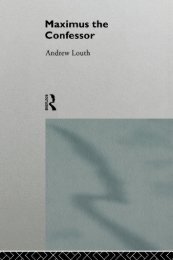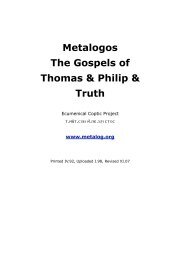Gospels of Thomas and Philip and Truth - Syriac Christian Church
Gospels of Thomas and Philip and Truth - Syriac Christian Church
Gospels of Thomas and Philip and Truth - Syriac Christian Church
Create successful ePaper yourself
Turn your PDF publications into a flip-book with our unique Google optimized e-Paper software.
composed <strong>of</strong> God’s imagination.<br />
VI. (Jn 5:19, Th 75, Ph 6 32 40 93 130 143) To know oneself as essentially a<br />
reflection <strong>of</strong> imagery in the mind <strong>of</strong> God, is then to know that one is ‘eternally born in<br />
the Bridal-Chamber’ <strong>of</strong> the mystical union <strong>of</strong> the Two into One: the Spirit with the<br />
Light, the Father with the Mother, the Bridegroom with the Bride¹, <strong>and</strong> Christ with the<br />
Totality. (¹recalling the Song <strong>of</strong> Songs)<br />
VII. (Th 83, Ph 78, Tr 8 17) But a (visual) mirror is itself a type <strong>of</strong> image, not<br />
somehow separate from the visual field. Just so are the two, the angel <strong>and</strong> the<br />
image, united: each individual is a unitary reflection within the divine imagery. And<br />
the incarnate Christ is proposed as the perfect mirror-image (‘face-form’) <strong>of</strong> the<br />
Father, in which God beholds himself ideally reflected. We ourselves, on the other<br />
h<strong>and</strong>, are intended by God as imperfect— though perfectible (Mt 5:48, Lk 1:6, Tr 53)<br />
— mirror-images in his imagination.<br />
VIII. (Jn 1:1-3, Ph 10 11 13 25 72 136, Tr 43) Remaining to be considered<br />
would be the entire topic <strong>of</strong> semantics, which is to say <strong>of</strong> the logos or meaning itself;<br />
what is it precisely that characterizes those images— sounds, pictures, gestures,<br />
inscriptions, etc., or thoughts there<strong>of</strong>— which serve as specifically linguistic icons or<br />
‘symbolic images’? And in what sense is an incarnate person a logos (<strong>and</strong> Christ the<br />
perfect Logos)? A sentence is, after all, itself a complex <strong>of</strong> images (whether physical<br />
or mental) which is being put to a communicative use; so we would presumably be<br />
saying that each incarnation is a divine communication (<strong>and</strong> Christ the perfect<br />
communication). Are then propositions <strong>and</strong> their components perhaps, like the<br />
persons who use them, essentially reflectional? This would imply that the descriptive<br />
meaning <strong>of</strong> language consists in a polydimensional ‘mirroring’ <strong>of</strong> its possible<br />
denotations— just as the identity <strong>of</strong> a person consists in his reflecting his own<br />
imagery <strong>and</strong> in his being a reflection (incarnation) <strong>of</strong> God. Here we would have to<br />
analyze the various interrelations <strong>of</strong> at least six parallel binaries: ego/imagery,<br />
substance/attribute, subject/object, subject/predicate, active/passive <strong>and</strong> variable/<br />
function— both among individuals <strong>and</strong> regarding the Godhead.<br />
IX. Regarding only the syntactical structure which is required e.g. in order to<br />
format noun-phrases <strong>and</strong> verb-phrases, we might well think that a person's being<br />
essentially a subjective mirroring <strong>of</strong> objective images could in itself enable him<br />
inherently to underst<strong>and</strong> the subject-predicate as well as the active-passive (Jn 5:19)<br />
grammatical forms. This would perhaps help to explain the necessarily innate<br />
122




